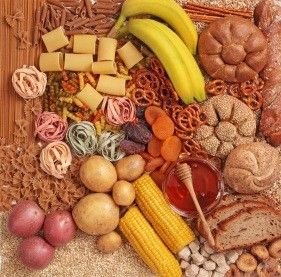Carbohydrate Definition
Carbohydrate Definition

Carbohydrates have gotten a bad reputation since the advent of the "low-carb" diet. Unfortunately, many people don't really know what the definition of a carb really is. More importantly, they don't know that there are good carbs and bad carbs, and the good ones are necessary for optimum health.
Simple and Complex
Carbohydrates are organic compounds, including starches, sugars, and fiber. Another way of saying this is that we have simple carbohydrates and complex carbohydrates.
Sugars can be monosaccharides (“one sugar”) or, when they are composed of two monosaccharides, they are called disaccharides (“two sugars”). Starches are polysaccharides (“many sugars”) and are composed of long chains of monosaccharides.
The -oses are sugars
The most common monosaccharides are glucose, fructose and galactose, and the most common disaccharides are maltose (alcohol sugar), sucrose (table sugar) and lactose (milk sugar). Of all of these sugars, glucose is the most important, because it is fuel for the brain and the muscles. You will sometimes hear glucose referred to as “blood sugar” because it circulates in the blood bringing energy to the brain and fuel to the muscles.
How much is enough
There is a great deal of disagreement in the health community about how much carbohydrate is needed in the diet.
Since carbohydrates encompass the Bread, Cereal, Rice and Pasta Group, as well as the Fruit and Vegetable Group, and even shares some foods with the Protein group, it is difficult to make an across-the-board recommendation for carbs.
Most experts agree that you should be eating more of your calories (some say as much as 55-60%) from the good carbohydrates category than from the Protein and Fats groups. Others say that you should eat fewer carbs and concentrate on protein and healthy fats.
My thought is that the diet that is best for you may vary based on a number of factors, including genetics, lifestyle and food availability, but eating moderate amounts of healthy carbs is generally a good choice for most people.
Of course if you have Celiac Disease or are allergic to certain carb foods, you will need to deal with that as a separate issue. You may want to meet with a dietitian or nutritionist to determine what is best for you.
Carbohydrate Definition - Starches and Fibers
Starches and fibers are the complex carbohydrates, also known as polysaccharides. Starches are stored by all of the plants we eat, and so, come almost exclusively from plant foods. Fibers make up the structures of plants and are classified as soluble fiber and insoluble fiber. Both types of fiber are essential to a healthy diet and lifestyle.
Why are carbohydrates good for you?
In addition to providing your body with fuel—glucose for brain function and muscle activity—carbohydrate foods contain vitamins, minerals and fiber, along with other protective phytochemicals, the value of which we have only just begun to appreciate. A carbohydrate-rich diet, especially with emphasis on whole grains, fruits and vegetables, may protect you from heart disease, diabetes, and some types of cancer. In addition, the fiber in many carb foods will contribute to elimination and decreased exposure to harmful toxins.
What is a serving of carbohydrate?
The serving size for carbohydrates varies according to type.
For the Bread, Cereal, Rice and Pasta Group, a serving would be 1 slice of bread, ½ cup cooked pasta, rice or cereal, 1 small roll, biscuit or muffin, ½ bagel or bun or 3 small crackers.
For vegetables, a serving would be ½ cup cooked or raw or 1 cup leafy greens and for fruits, a serving would be 1 medium for most fruits, 1 melon slice, ½ grapefruit or ½ c. berries or canned fruit. A serving of vegetable or fruit juice is ¾ cup.
What to remember about this carbohydrate definition
Healthy eating involves choosing carbohydrates from a variety of sources. Concentrate on whole grains and colorful fruits and vegetables. Be aware of your portions, especially of the starchy carbs and limit or avoid processed carbs such as sugary and white flour products..
Glossary for Carbohydrate Definition page
Bad Carbs are carbohydrate foods that are usually very processed and do not provide much in the way of nutrients other than calories, including white bread, cookies, doughnuts, chips, snack cakes, soft drinks, pastries.
Good carbs are Fruits, Vegetables, Whole grains and healthy products made from them. Legumes and Some Nuts, such as cashews, contain significant amounts of healthy carbohydrate.
Celiac Disease - an autoimmune condition where you have an inflammatory response to eating anything containing gluten, the main protein found in some grains It is believed that the mechanism of this disease is that the gluten causes damage to the lining of your small intestine, making it difficult to absorb nutrients. This means that, in spite of eating an adequate diet, you are literally starving to death, since your body cannot take advantage of the nutrients in the foods you are eating. Symptoms may include fatigue, diarrhea, and unexplained weight loss. Some people may also experience abdominal pain, nausea and bloating.
Phytochemicals are chemicals found in plant foods that effect your health and whose role in human nutrition is only just beginning to be understood. They can be divided into several groups including flavonoids, carotenoids, phytosterols, polyphenols and organosulfur compounds.
Click here to go from Carbohydrate Definition page to Small Bites page.

